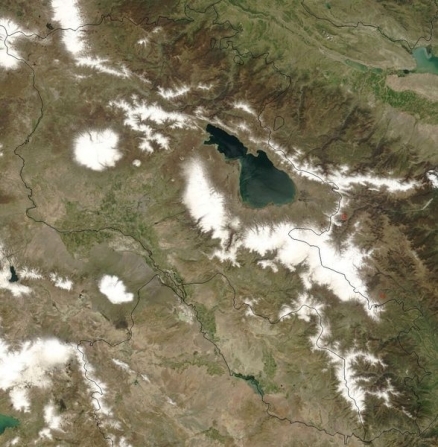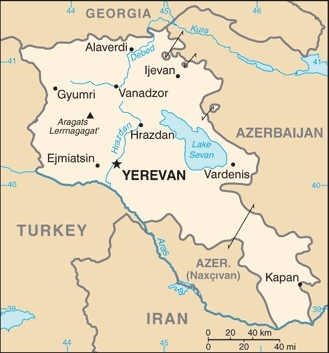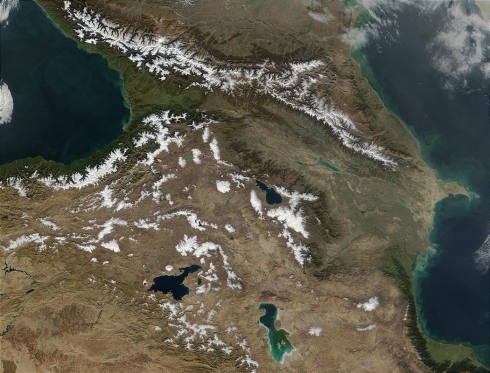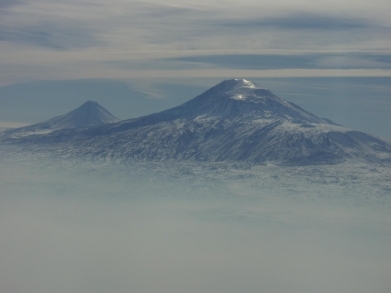Armenia
Countries and Regions of the World Collection  Armenia is a landlocked nation of about 3 million people in Southwestern Asia, between Turkey (to the west) and Azerbaijan.
Armenia is a landlocked nation of about 3 million people in Southwestern Asia, between Turkey (to the west) and Azerbaijan.
It liesin the Lesser Caucasus Mountains and includes Sevana Lich (Lake Sevan), the largest lake in this mountain range.
Its major environmental issues include:
- soil pollution from toxic chemicals such as DDT;
- the energy crisis of the 1990s led to deforestation when citizens scavenged for firewood;
- pollution of Hrazdan (Razdan) and Aras Rivers;
- the draining of Sevana Lich (Lake Sevan), a result of its use as a source for hydropower, threatens drinking water supplies;
- restart of Metsamor nuclear power plant in spite of its location in a seismically active zone.
Armenia is susceptible to occasionally severe earthquakes and droughts.
Armenia prides itself on being the first nation to formally adopt Christianity (early 4th century). Despite periods of autonomy, over the centuries Armenia came under the sway of various empires including the Roman, Byzantine, Arab, Persian, and Ottoman.
During World War I in the western portion of Armenia, Ottoman Turkey instituted a policy of forced resettlement coupled with other harsh practices that resulted in an estimated 1 million Armenian deaths.
The eastern area of Armenia was ceded by the Ottomans to Russia in 1828; this portion declared its independence in 1918, but was conquered by the Soviet Red Army in 1920.
Armenian leaders remain preoccupied by the long conflict with Azerbaijan over Nagorno-Karabakh, a primarily Armenian-populated region, assigned to Soviet Azerbaijan in the 1920s by Moscow. Armenia and Azerbaijan began fighting over the area in 1988; the struggle escalated after both countries attained independence from the Soviet Union in 1991. By May 1994, when a cease-fire took hold, ethnic Armenian forces held not only Nagorno-Karabakh but also a significant portion of Azerbaijan proper.
The economies of both sides have been hurt by their inability to make substantial progress toward a peaceful resolution. Turkey closed the common border with Armenia in 1994 because of the Armenian separatists' control of Nagorno-Karabakh and surrounding areas, further hampering Armenian economic growth.
In 2009, senior Armenian leaders began pursuing rapprochement with Turkey, aiming to secure an opening of the border.
Contents
Geography
Location: Southwestern Asia, between Turkey (to the west) and Azerbaijan
Geographic Coordinates: 40 00 N, 45 00 E
Area: 29,743 sq km (28,203 sq km land and 1,540 sq km water)
Land Boundaries: 1,254 km (Azerbaijan-proper 566 km, Azerbaijan-Naxcivan exclave 221 km, Georgia 164 km, Iran 35 km, Turkey 268 km)
Natural Hazards: occasionally severe earthquakes; droughts
Terrain: Armenian Highland with mountains; little forest land; fast flowing rivers; good soil in Aras River valley. The highest point is Aragats Lerrnagagat' 4,090 m and the lowest point Debed River 400 m.
Climate: highland continental, hot summers, cold winters
Ecology and Biodiversity
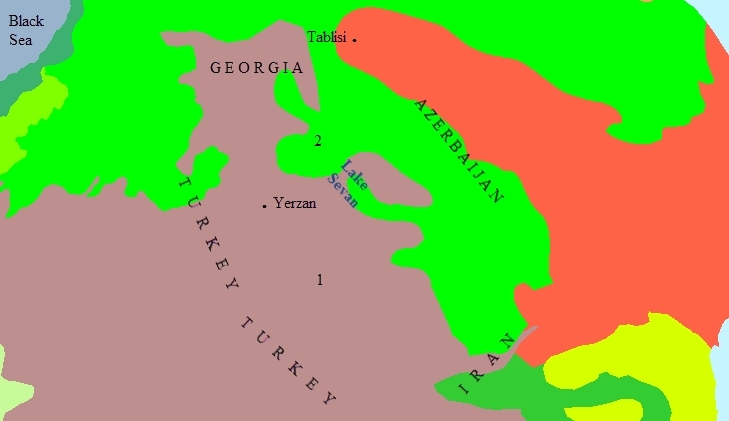 Ecoregions of Armenia. Source: World Wildlife Fund
Ecoregions of Armenia. Source: World Wildlife Fund
- Eastern Anatolian montane steppe
- Caucasus mixed forests
See also
- Biological diversity in the Irano-Anatolian
People and Society
Population: 2,970,495 (July 2012 est.)
Ethnic Groups: Armenian 97.9%, Yezidi (Kurd) 1.3%, Russian 0.5%, other 0.3% (2001 census)
| Often regarded as the southeastern border of Europe, the Caucasus Mts stretch from the Black Sea (left) to the Caspian Sea (right). The mountain range spans 1,125 km (700 mi), forming part of the southern Russian border, and crossing Georgia, Armenia, and Azerbaijan from left to right respectively. With a snowline of approximately 3,350 m (11,000 ft) and many peaks over 4,500 m (14,760 ft), much of the snow seen in this image is present year round. Also visible in this photo are apparent phytoplankton blooms in the Caspian Sea, marked by blue-green swirls. Image credit: NASA |
| A view of Mount Ararat in western Turkey through the fog. The highest of its two peaks, Greater Ararat, is the tallest mountain in Turkey at 5,166 m (16,949 ft). Although located some 32 km (20 mi) from the Armenian border, the dormant volcano dominates the skyline of Yerevan, Armenia's capital. This photo was snapped after take off from the Yerevan airport. |
Age Structure:
0-14 years: 17.6% (male 279,304/female 242,621)
15-64 years: 72.4% (male 1,006,312/female 1,141,430)
65 years and over: 10.1% (male 112,947/female 185,361) (2011 est.)
Population Growth Rate: 0.107% (2012 est.)
Birthrate: 12.9 births/1,000 population (2012 est.)
Death Rate: 8.49 deaths/1,000 population (July 2012 est.)
Net Migration Rate: -3.35 migrant(s)/1,000 population (2012 est.)
Life Expectancy at Birth: 73.49 year
male: 69.85 years
female: 77.56 years (2012 est.)
Total Fertility Rate: 1.38 children born/woman (2012 est.)
Languages: Armenian (official) 97.7%, Yezidi 1%, Russian 0.9%, other 0.4% (2001 census)
Literacy (age 15 and over can read and write): 99.4%
Urbanization: 64% of total population (2010) growing at an annual rate of change of 0.5% (2010-15 est.)
History
Armenia first emerged around 800 BC as part of the Kingdom of Urartu or Van, which flourished in the Caucasus and eastern Asia Minor until 600 BC. After the destruction of the Seleucid Empire, the first Armenian state was founded in 190 BC. At its zenith, from 95 to 65 BC, Armenia extended its rule over the entire Caucasus and the area that is now eastern Turkey, Syria, and Lebanon. For a time, Armenia was the strongest state in the Roman East. It became part of the Roman Empire in 64 BC.
In 301 AD, Armenia became the first nation to adopt Christianity as a state religion, establishing a church that still exists independently of both the Roman Catholic and the Eastern Orthodox churches. Since then, the Armenian nation has depended on the church to preserve and protect its national identity. From around 1100 to 1350, the focus of the Armenian nation moved south, as the Armenian Kingdom of Cilicia, which had close ties to European Crusader states, flourished in southeastern Asia Minor until it was conquered by Muslim states. Between the 4th and 19th centuries, ethnic Armenians were conquered and ruled by, among others, Persians, Byzantines, Arabs, Mongols, and Ottoman Turks. For a brief period from 1918 to 1920, Armenia re-emerged as an independent republic. In late 1920, local communists came to power following an invasion of Armenia by the Soviet Red Army, and in 1922, Armenia became part of the Trans-Caucasian Soviet Socialist Republic. In 1936, it became the Armenian Soviet Socialist Republic. Armenia declared its independence from the Soviet Union on September 21, 1991.
Government
Armenians voted overwhelmingly for independence in a September 1991 referendum, followed by a presidential election in October 1991 that gave 83% of the vote to Levon Ter-Petrossian. Ter-Petrossian had been elected head of government in 1990, when the Armenian National Movement defeated the Communist Party. Ter-Petrossian was re-elected in 1996 in a disputed election. Following public demonstrations against Ter-Petrossian's policies on the predominantly ethnic Armenian enclave of Nagorno-Karabakh that is located within Azerbaijan, the President resigned under pressure in January 1998 and was replaced by Prime Minister Robert Kocharian, who was subsequently elected President in March 1998. Following the October 27, 1999 assassination in Parliament of Prime Minister Vazgen Sargsian, Parliament Speaker Karen Demirchian, and six other officials, a period of political instability ensued during which an opposition headed by elements of the former Armenian National Movement government attempted unsuccessfully to force Kocharian to resign. Riding out the unrest, Kocharian was later reelected in March 2003 in a contentious election that the Organization for Security and Cooperation in Europe (OSCE) and the U.S. Government deemed to have fallen short of international standards.
The Government of Armenia's stated aim is to build a Western-style parliamentary democracy as the basis of its form of government. However, international observers have been critical of the conduct of national elections in 1995, 1999, 2003, 2008, as well as the constitutional referendum of 2005. The new constitution in 2005 increased the power of the legislative branch and allows for more independence of the judiciary; in practice, however, both branches remain subject to political pressure from the executive branch, which retains considerably greater power than its counterparts in most European countries.
The unicameral National Assembly has a total of 131 seats: 90 seats are elected by proportional representation (party list), and 41 are single mandate districts. Armenia held its most recent parliament elections in 2007, when the Republican Party of Armenia (RPA) won 33 percent of the votes cast, followed by Prosperous Armenia (15 percent), the Armenian Revolutionary Federation Dashnaktsutyun (ARF) (13 percent), Rule of Law (7 percent), and the Heritage Party (6 percent). This election as well was marred by irregularities. The RPA and Prosperous Armenia joined to form a governing coalition which secured an absolute majority of parliament seats. The ARF negotiated a cooperation agreement with the governing coalition in exchange for ministerial positions, but declined to join the coalition formally, instead reserving the right to support its own candidate for the February 2008 presidential election.
Following the 2008 presidential elections the Republican Party of Armenia, Prosperous Armenia, the Rule of Law, and the ARF signed a new coalition agreement on March 21, 2008. The ARF dropped out of the coalition in April 2009 citing differences over the conduct of foreign policy.
Armenia held presidential elections on February 19, 2008. While originally deemed by the OSCE’s Office for Democratic Institutions and Human Rights (ODIHR) to be “mostly in line” with OSCE standards, the elections were later seen to be marred by credible claims of ballot stuffing, intimidation (including beatings) of poll workers and proxies, vote buying, and other irregularities. Recounts were requested, but ODIHR observers noted “shortcomings in the recount process, including discrepancies and mistakes, some of which raise questions over the impartiality of the Commissions concerned.”
Mass protests followed the disputed vote. For 10 days, large crowds of pro-opposition demonstrators gathered in Yerevan’s downtown Freedom Square. Police and security forces entered Freedom Square early in the morning on March 1, 2008, ostensibly to investigate reports of hidden weapons caches. This operation turned into a forced dispersal of demonstrators from Freedom Square by massed riot police. Following the clearing of Freedom Square, clashes erupted in the afternoon between massed demonstrators and security personnel, and continued throughout the day and evening, leading to ten deaths and hundreds of injuries. President Kocharian decreed a 20-day state of emergency in Yerevan late on March 1, which sharply curtailed freedom of media and assembly. Dozens of opposition supporters were jailed in the wake of the violence, in proceedings that many international watchdog groups have criticized as politically motivated. Armenia's media freedom climate and freedom of assembly remained poor overall, though somewhat improved after the state of emergency was lifted. In June 2009 and May 2011, President Sargsian proposed and the Parliament approved two general amnesties which resulted in the release from jail of all those detained in connection with the March 2008 events. In the spring of 2011, the leading opposition group was also able to resume -- after a three-year prohibition -- the holding of authorized rallies in Yerevan’s Freedom Square. In April 2011, President Sargsian called for a more meticulous examination of the violence that followed the elections-related protests in 2008. Those responsible for the 10 deaths have not yet been identified and held accountable.
Upcoming elections will be held in May 2012 for the Armenian National Assembly and February 2013 for the Presidency.
Government Type:
Capital: Yerevan (population 1.11 million in 2009)
Adminsitrative Divisions: 11 provinces (marzer, singular - marz); Aragatsotn, Ararat, Armavir, Geghark'unik', Kotayk', Lorri, Shirak, Syunik', Tavush, Vayots' Dzor, Yerevan
Independence Date: 21 September 1991 (from the Soviet Union)
Legal System: civil law system. Armenia has not submitted an International Court of Justice (ICJ) jurisdiction declaration and is a non-party state to the International Court of Justice (ICCt)
International Environmental Agreements
Armenia is party to international treaties on Air Pollution, Biodiversity, Climate Change, Climate Change-Kyoto Protocol, Desertification, Environmental Modification, Hazardous Wastes, Law of the Sea, Ozone Layer Protection, and Wetlands. It has signed, but not ratified a treaty on Air Pollution-Persistent Organic Pollutants.
Environmental Isssues
Armenia is trying to address its environmental problems. The Ministry of Nature Protection has introduced a pollution fee system by which taxes are levied on air and water emissions and solid waste disposal, with the resulting revenues used for environmental protection activities. Deforestation by mining concerns in certain parts of the country, especially the Teghut Forest in the Lori marz (region), have resulted in periodic protests by environmental non-governmental organizations (NGOs), and stirred controversy over government policies to support investment in the mining sector. Armenia is interested in cooperating with other members of the Commonwealth of Independent States (CIS--a group of 11 former Soviet republics) and with other members of the international community on environmental issues. Armenia has been under strong pressure from the international community to close its thirty-five-year-old nuclear power plant (ANPP) at Metsamor by 2016. This pressure has only increased in the aftermath of the Fukushima nuclear disaster in Japan in March 2011. Given that Armenia depends on the ANPP for roughly 40% of its electricity, the Armenian Government sees no alternative to construction of a new nuclear plant. The Armenian Government is continuing to plan for a new plant. The U.S. Government will continue to provide technical assistance to support the Armenian Government’s efforts to ensure that any nuclear unit meets proper safety and environmental standards.
Water
Total Renewable Water Resources: 10.5 cu km (1997)
Freshwater Withdrawal: 2.95 cu km/yr (30% domestic, 4% industrial, 66% agricultural) - 977 cu m/yr (2000) per capita.
See: Water profile of Armenia
Agriculture
Agricultural products: fruit (especially grapes), vegetables; livestock
Irrigated Land: 2,740 sq km (2008)
Resources
Armenia has some mineral deposits (copper, gold, bauxite). Pig iron, unwrought copper, and other nonferrous metals are Armenia's highest valued exports.
Natural Resources: small deposits of gold, copper, molybdenum, zinc, bauxite
Land Use:
arable land: 16.78%
permanent crops: 2.01%
other: 81.21% (2005)
Economy
Armenia is the second most densely populated of the former Soviet republics. Armenia is a landlocked country between the Black and the Caspian Seas, bordered on the north by Georgia, to the east by Azerbaijan, on the south by Iran, and to the west by Turkey. Up until independence in 1991, Armenia's economy was based largely on industry--chemicals, electronic products, machinery, processed food, synthetic rubber, and textiles--and highly dependent on outside resources. Agriculture accounted for only 20% of net material product and 10% of employment before the breakup of the Soviet Union. Construction, which was the leading sector of the economy for the past eight years, constituting 27% of the country's GDP in 2008, declined by 34.6% in 2009 and 3.3% in 2010. In 2011, the sector continued to shrink, with a decrease of 11.5 percent compared to 2010. The beginning of the slowdown in construction coincided with the tense political situation connected to the presidential election campaign and the post-election civil unrest in 2008. Market saturation, a drop in demand related to the global economic crisis, and a steep decline in foreign remittances contributed to the further slowdown.
Like other New Independent States of the former Soviet Union, Armenia's economy still suffers from the legacy of a centrally planned economy and the breakdown of former Soviet trading networks. While investment from these states in support of Armenian industry has virtually disappeared, and few major enterprises are still able to function, Russian entities have nevertheless increased their ownership in the mining, energy, telecommunications, and transportation sectors. In addition, the effects of the 1988 earthquake, which killed more than 25,000 people and made 500,000 homeless, are still being felt, though international donors and diaspora Armenian groups continue to fund reconstruction efforts in the earthquake zone.
Although a cease-fire has held since 1994, the 20-year-old conflict with Azerbaijan over Nagorno-Karabakh has not been resolved. While intensive efforts by the OSCE Minsk Group are ongoing in pursuit of a settlement, the closure of both the Azerbaijani and Turkish borders has prevented Armenia from realizing its economic potential. Armenia's economy depends heavily on outside supplies of energy and most raw materials. While land routes to Turkey are closed, regular and charter air connections operate between Yerevan and Istanbul and Antalya; land routes through Georgia and Iran raise the risk and cost of transport.
The structure of Armenia's economy has changed substantially since independence in 1991, with sectors such as construction and services replacing agriculture and industry as the main contributors to economic growth. The diamond processing industry, which was one of the leading export sectors in 2000-2004 and a major recipient of foreign investment, faced a dramatic decrease in output since 2005 due to raw material supply problems with Russia and an overall decline in international diamond markets. Other industrial sectors driving industrial growth include energy, metallurgy, and food processing.
Despite the Nagorno-Karabakh conflict, the Government of Armenia has been able to carry out wide-ranging economic reforms that have paid off in dramatically lower inflation and relatively steady growth. Armenia registered strong economic growth after 1995, with double-digit GDP growth rates every year from 2002 to 2007.
After rapid expansion in 2001-2007, economic and financial conditions worsened rapidly in Armenia in 2008, due to a drop in international metals prices and a downturn in the Russian economy following the collapse of oil prices in late 2008. The end of a remittance-fueled construction boom that had driven growth in recent years resulted in a 14.4% drop of real GDP for 2009 (compared to 6.8% GDP growth in 2008), with about 80% of this decline due to a plunge in the construction sector. Since 2008, Armenia has experienced a significant drop in investment, exports, and real incomes primarily caused by the global financial crisis. The Government of Armenia’s (GOAM) anti-crisis measures, additional loans and budgetary support from international donors helped to avoid further economic decline in 2010. However, economic indicators, while on the rebound, still fall short of the pre-crisis growth trend for the two decades following independence. Gradual recovery of remittance flows in comparison to 2010 also contributed to the slight upturn. Nevertheless, poverty and prices remain high, and the sustainability of growth remains a concern. Some of the major impediments for potential investors remain the lack of transparency in the tax and customs administration, the unpredictability of doing business in Armenia, and unequal competition between domestic and foreign firms.
Armenia maintains a floating exchange rate regime with no explicit exchange rate target. The nominal exchange rate of the Armenian dram with major currencies was fairly stable between 1998 and 2003. During 2003-2007, the Armenian Dram appreciated sharply against the U.S. dollar by around 45%, mainly due to significant growth in remittances, growth of exports in absolute terms, the de-dollarization of the economy and weakening of the dollar in international markets. The appreciation of the dram affected negatively the traditional export industries, including information technologies, diamond cutting, the wine industry, and textiles. Exporters responded to the increased costs by either reducing their capacities of production or by reducing their number of employees in order to stay afloat. During 2008, the exchange rate was mainly stable at around 300 drams per dollar, until March 2009, when the Central Bank stopped its heavy intervention in the foreign exchange market and announced that it would adopt a floating currency regime. As a result, the Dram devalued by around 25%. It remained at this rate until a smooth devaluation took place throughout 2011, after which the Dram reached its current level of approximately 390 drams per dollar.
Armenia is highly dependent on the import of energy fuel, mainly from Russia. The Armenia Nuclear Power Plant (ANPP) at Metsamor provides around 40% of electricity generation for the country, and hydro and thermal plants provide roughly 30% each. Armenia imports most of its natural gas from Russia, which provided significant discounts to Armenia until 2009. Russian import gas prices rose from $110 to $154 per thousand cubic meters in April 2009, and increased further to $180 in April 2010. The gas price was set to further rise in April 2011 to approach the international market price, but this has been temporarily averted as a result of extensive negotiations between the Russian and Armenian governments. However, the current price is still below the international average of over $300, and in the coming years the price is expected to converge with market prices.
Since May 2006 Armenia has also received natural gas from Iran through a direct pipeline between the two countries, in addition to tanker trucks. As a result of a Gazprom-brokered deal, Armenia and Iran participate in a program of direct exchange of natural gas for electric power, which has diversified Armenia’s supply of gas products.
Armenia imports nearly all of its refined petroleum products through Georgia. The August 2008 conflict between Russia and Georgia resulted in periodic disruptions of fuel and food imports, and highlighted Armenia's vulnerability to disruptions in this primary transit corridor.
Armenia has received significant support from international institutions. The International Monetary Fund (IMF), World Bank, European Bank for Reconstruction and Development (EBRD), and other international financial institutions (IFIs) and foreign countries, particularly Russia, are extending considerable grants and loans. These loans are targeted at reducing the budget deficit, stabilizing the local currency; developing private businesses; energy and the agriculture, food processing, transportation, and health and education sectors. In 2009 Armenia received more than $ 1.5 billion in donor financing for budget support and different government-led anti-crisis programs. In 2011, the Eurasian Economic Community (EurAsEC), an economic organization in which Russia is a principal participant, provided a loan of $500 million to finance Armenia’s external debt and restructure a number of branches of the Armenian economy, in return for the transfer of major assets. Further, Russian energy conglomerates have pledged to invest $71 million in natural gas and electricity distribution networks in Armenia.
Continued economic growth will depend on the ability of the government to strengthen its macroeconomic management, including increasing revenue collection, improving the investment climate, and combating significant corruption. A liberal foreign investment law was approved in June 1994, and a Law on Privatization was adopted in 1997, as well as a program on state property privatization. Armenia joined the World Trade Organization on February 5, 2003. Armenia recently acceded to the WTO’s Agreement on Government Procurement which imposes an obligation to improve its existing procurement practices.
Armenia has managed to reduce poverty, slash inflation, stabilize its currency, and privatize most small- and medium-sized enterprises.
Armenia is particularly dependent on Russian commercial and governmental support and most key Armenian infrastructure is Russian-owned and/or managed, especially in the energy sector. The electricity distribution system was privatized in 2002 and bought by Russia's RAO-UES in 2005. Construction of a pipeline to deliver natural gas from Iran to Armenia was completed in December 2008, and gas deliveries are slated to expand due to the April 2010 completion of the Yerevan Thermal Power Plant.
The government made some improvements in tax and customs administration in recent years, but anti-corruption measures have been ineffective and the current economic downturn has led to a sharp drop in tax revenue and forced the government to accept large loan packages from Russia, the IMF, and other international financial institutions. Armenia will need to pursue additional economic reforms in order to regain economic growth and improve economic competitiveness and employment opportunities, especially given its economic isolation from two of its nearest neighbors, Turkey and Azerbaijan.
GDP: (Purchasing Power Parity): $17.95 billion (2011 est.)
GDP: (Official Exchange Rate): $9.8 billion (2011 est.)
GDP- per capita (PPP): $5,400 (2011 est.)
GDP- composition by sector:
agriculture: 17.8%
industry: 37.7%
services: 44.5% (2011 est.)
Imports: natural gas, petroleum, tobacco products, foodstuffs, diamonds
Exports: pig iron, unwrought copper, nonferrous metals, diamonds, mineral products, foodstuffs, energy
Industries: diamond-processing, metal-cutting machine tools, forging-pressing machines, electric motors, tires, knitted wear, hosiery, shoes, silk fabric, chemicals, trucks, instruments, microelectronics, jewelry manufacturing, software development, food processing, brandy.
Currency: Drams (AMD)
